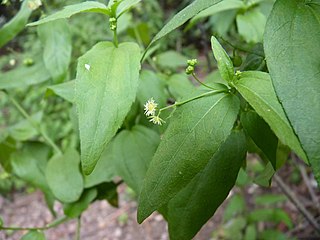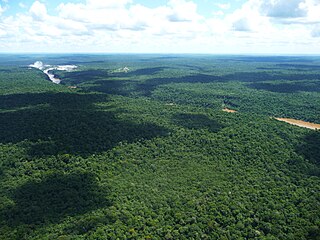
Myrceugenia is a genus of evergreen woody flowering trees and shrubs belonging to the myrtle family, Myrtaceae, first described as a genus in 1855. The genus is native to South America from central Brazil to southern Chile. It is closely related to the genus Luma; some botanists include Myrceugenia in that genus.

The South Region of Brazil is one of the five regions of Brazil. It includes the states of Paraná, Rio Grande do Sul, and Santa Catarina, and covers 576,409.6 square kilometres (222,553.0 sq mi), being the smallest region of the country, occupying only about 6.76% of the territory of Brazil. Its whole area is smaller than that of the state of Minas Gerais, in Southeast Brazil, for example.

Chiropetalum is a plant genus of the family Euphorbiaceae first described as a genus in 1832. It is widespread across relatively dry regions of North and South America from Texas to Uruguay.

Polish Brazilians refers to Brazilians of full or partial Polish ancestry who are aware of such ancestry and remain connected, to some degree, to Polish culture, or Polish-born people permanently residing in Brazil. Also, a Polish Brazilian may have one Polish parent.

Vriesea is a genus of flowering plants in the botanical family Bromeliaceae, subfamily Tillandsioideae. The genus name is for Willem Hendrik de Vriese, Dutch botanist, physician (1806–1862). Its species are widespread over Mexico, Central America, South America and the West Indies.

The Alto Paraná Atlantic forests, also known as the Paraná-Paraíba interior forests, is an ecoregion of the tropical moist forests biome, and the South American Atlantic Forest biome. It is located in southern Brazil, northeastern Argentina, and eastern Paraguay.

Dyckia is a genus of plants in the family Bromeliaceae, subfamily Pitcairnioideae.

Oxypetalum is a genus of flowering plants in the family Apocynaceae, first described with this name in 1810. The genus is native to South America.

The marsh antwren, also known as the Paraná antwren, is an insectivorous bird in the antbird family Thamnophilidae. It is endemic to marshes and swamps in the Brazilian states of Paraná and Santa Catarina.
Neomitranthes is a genus of plant in family Myrtaceae first described as a genus in 1977. The entire genus is endemic to Brazil.
The Kaingang language is a Southern Jê language spoken by the Kaingang people of southern Brazil. The Kaingang nation has about 30,000 people, and about from 60% to 65% speak the language. Most also speak Portuguese.
Stomatanthes is a genus of African and South American plants in the tribe Eupatorieae within the family Asteraceae.

The 2009 swine flu pandemic in Brazil began on April 25, 2009, with two people, spreading to 34 over the first two weeks. CDC calculate that Africa and Southeast Asia, which have 38% of the world's population, accounted for a disproportionate 51% of the deaths.
Neocabreria is a genus of Brazilian flowering plants in the tribe Eupatorieae within the family Asteraceae.
Symphyopappus is a genus of South American plants in the tribe Eupatorieae within the family Asteraceae.

Urolepis is a genus of South American plants in the tribe Eupatorieae within the family Asteraceae.
Dallwatsonia is a genus of Australian, Asian, and Neotropical plants in the grass family. Most of the species have been incorporated into the genus only recently, transferred from Panicum in 2014.

Stenachaenium is a genus of South American plants in the family Asteraceae.
Picramnia parvifolia, the cedrinho, is a tree species that occurs in Brazil, in the regions Sudeste and Sul, and in Paraguay.











